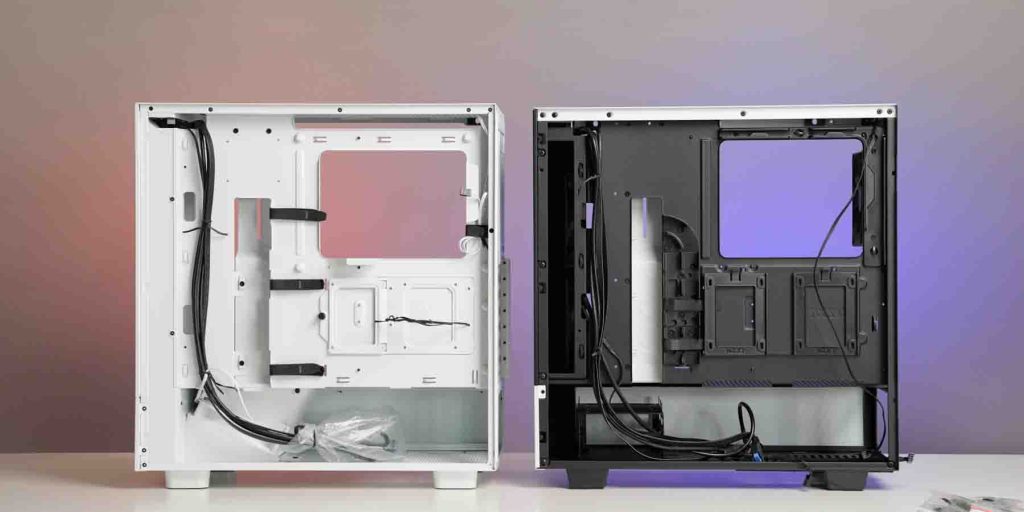NZXT’s new H5 case replaces the older H510. It keeps the simple and clean design language that has made the 5-series from NZXT popular but makes a few changes to the build process. A larger mesh mount on top allows more cooling options, cable management has been optimized, and a new GPU-focused 120mm fan made the new H5 an appealing case for me to try out. Are these updates worth the $95 price tag NZXT is charging for the H5 Flow? Be sure to hit the video below to see all of the details.
In addition to the H5 Flow which prioritizes airflow with the mesh front panel, NZXT also offers the $140 H5 Elite. Just like the older H510 Elite, this model has a tempered glass front panel and comes with additional RGB fans and a controller. I wanted to prioritize airflow, so I opted for the Flow model.
Earlier this year, I reviewed the Foundation PC which came in a standard H510 case. After enjoying the look of that case, I upgraded my main PC to the H510 flow – seeking a case that was more aesthetically pleasing on my desktop. Having just swapped everything from the H510 to the H5, I have a few thoughts on the build process and the updates to the new case.
H510 Flow vs H5 Flow: The differences
While the basic idea is the same between the two cases, there are quite a few differences. First, the new H5 is about ¾ of an inch wider than the older model. That may not seem like much, but it gives some more wiggle room for cable management behind the side door. It also makes the case take up just a little more room on a desk as well. If space is tight for your setup, that might make a big difference.

One big change here is the fan placement. NZXT still mounts one in the back but the second fan is located down in front of where the PSU goes and has a plastic shroud that points the air toward the GPU. Whether this makes a big difference, I’m not sure as my RTX 2070 Super was running at about 78°C after 12 minutes in the Heaven benchmark.
On the subject of airflow, the H5 also has a large mesh on top now rather than the small area from the older H510. With this new design, the case can support up to a 240mm radiator. The front mesh is also a bit different and can support up to a 280mm radiator.
How is it to build in?
The last differences take us to the building experience. On the older H510, there were hard plastic channels that were, in my experience, a bit hard to work with. The H5 has removed those hard channels and gone simply with velcro straps that are easier to work with.
Additionally, the gap above the motherboard has been expanded making running cables a bit easier. That may seem like a small difference, but once again, it was something I noticed when compared to the previous model.
Now, I’m not a veteran PC builder. I’ve swapped cases and components a handful of times. From my novice-level experience, though, I’ve found the H5 to be easy to build in. I definitely found it easier to work with than the older H510.
NZXT H5 Flow: Video
For the price point, I didn’t have any issues with the build quality. When the case is empty there can be some rattle, but once everything is assembled I didn’t notice rattles, noises, or anything that caused me to have issue with the build quality.
The only thing that looks a bit off is the magnetic mesh cover on top of the case. Because of its flexible mesh design, the middle dips in and looks like the top of the case dips in. It’s not always noticeable but from some angles, this can make the case look a little more cheap.
Cooling
Stock, the H5 comes with the new GPU fan and the fan at the back of the case. I’m not running a bleeding-edge PC build, and I don’t have a backlog of benchmark temperatures for comparing this case, but here is what I was getting from my build:
Computer specs:
- CPU: AMD Ryzen 7 3700X
- GPU RTX 2070 Super
CPU temps:
- 10-minute Cinebench benchmark
- 66°C
GPU temps:
- 12-minute Heaven benchmark
- 78°C
That seems reasonable to me, but I have ordered a few more RGB fans to put in the case at the front panel. That’s another benefit of this case to me is that it is easy to expand on if more cooling is required. Radiators can be mounted in front or up to and with more mesh on top, airflow will be easier to control.
Electronicsforward’ Take
For $95 is the NZXT H5 a great case? It depends on what your needs are but for me, it is exactly what I am looking for in a case. The simple design makes it aesthetically pleasing to me, and I enjoy having it in the background of my videos. I found building in the case easier than the older model and more mesh coverage means airflow can be controlled easier.
Buy NZXT H5 Flow
FTC: Electronicsforward is reader supported, we may earn income on affiliate links
Subscribe to the Electronicsforward YouTube Channel for all of the latest videos, reviews, and more!
